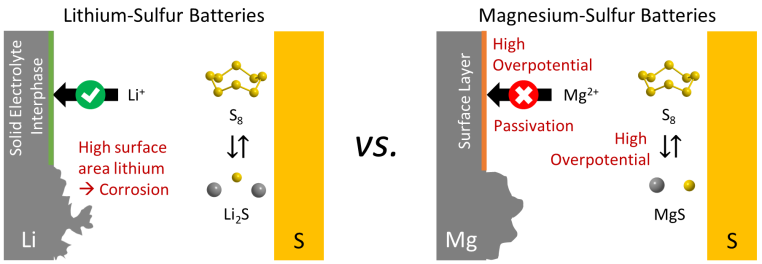A Comparison of Lithium-Sulphur and Magnesium-Sulphur Batteries
Realising higher energy densities with cheap and available raw materials combines various goals of battery research. Lithium-sulphur and magnesium-sulphur batteries are potential candidates for surpassing the energy density of the currently used lithium-ion battery. In particular in magnesium-sulphur, cheaper and more available raw materials are used for this purpose. According to the current state of research, however, the energy density has only been achieved theoretically. A team of scientists from MEET Battery Research Center of the University of Münster has investigated the reasons explaining the gap, the differences between the two technologies and their realistic future perspectives.
Electrolyte as a Determining Factor
In order to achieve a high energy density with magnesium-sulphur batteries not only theoretically but also practically, the overpotentials at the magnesium anode and at the sulphur cathode must be significantly reduced – one central result of the review article. In this context, the electrolyte design plays an essential role. “In recent years, research on magnesium-sulphur batteries has already achieved a major breakthrough with the development of an electrolyte that is not reactive towards sulphur. Now we need to further specify the electrolyte to facilitate the electrochemical processes at both electrodes”, says Dr Georg Bieker.

To realise magnesium-sulphur batteries, the high electrolyte amount must also be reduced significantly. Until now, magnesium-sulphur batteries have required considerably larger amounts of electrolyte than lithium-sulphur batteries in order to dissolve the polysulphides formed at the sulphur cathode during charging and discharging. Battery researcher Martin Kolek clarifies: “Magnesium cations interact more intensely with polysulphide anions than lithium cations. This reduces the stability and solubility of the polysulphides. We have shown that an optimised electrolyte design can reduce this interaction and consequently increase the stability and solubility of the polysulphides."
Focused Research on Both Technologies
The investigated differences between the lithium and magnesium species involved in lithium-sulphur and magnesium-sulphur batteries and the observed electrochemical processes at material level enables to advance research on both technologies systematically. MEET scientist Verena Küpers explains: “Many of the challenges of the magnesium-sulphur battery are rooted in the nature of the magnesium species. The same applies to the lithium-sulphur battery, where the lithium species has a strong influence. Research should intensively focus on these aspects.”
While the lithium-sulphur battery is currently entering niche markets, the technological readiness level (TRL) of the magnesium-sulphur battery is less developed. “The technology is still in the stage of basic research. At this juncture it cannot be clearly determined whether it will be able to compete with the currently commercially available battery technologies in the future”, explains Küpers.
The scientists Dr Georg Bieker, Martin Kolek, Verena Küpers and Prof. Dr Martin Winter from MEET Battery Research Center have published the detailed results of their study as an open access article in the journal “Communications Materials”.

